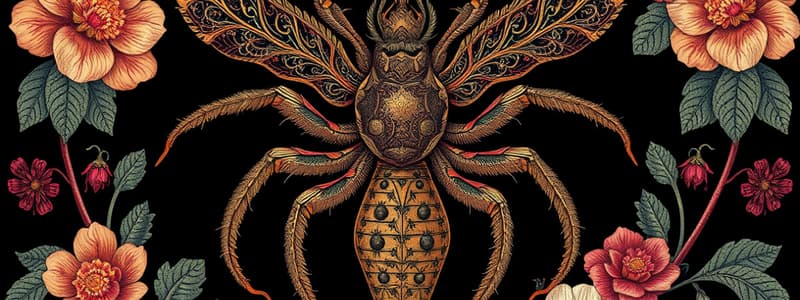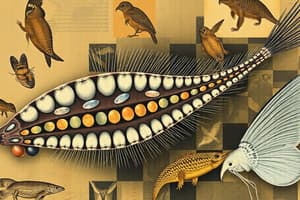Podcast
Questions and Answers
The Phylum Rotifera is named after what characteristic feature?
The Phylum Rotifera is named after what characteristic feature?
Ciliated crown
Select all functions of a rotifer's corona.
Select all functions of a rotifer's corona.
- Reproduction
- Locomotion (correct)
- Excretion
- Feeding (correct)
The epidermis of a rotifer is?
The epidermis of a rotifer is?
- Next to bands of muscle
- Responsible for cuticle secretion
- Syncytial
- All of the above (correct)
What are known environments for rotifers?
What are known environments for rotifers?
A nonliving external layer secreted by the epidermis of many protostomes is called a?
A nonliving external layer secreted by the epidermis of many protostomes is called a?
Members of the phylum ____________ inhabit tropical and polar climates, can be found in freshwater and saltwater, and are parasitic to plants and animals.
Members of the phylum ____________ inhabit tropical and polar climates, can be found in freshwater and saltwater, and are parasitic to plants and animals.
The ciliated crown on the head of a rotifer is called a(n)?
The ciliated crown on the head of a rotifer is called a(n)?
Which of the following are distinguishing characteristics of all Nematodes?
Which of the following are distinguishing characteristics of all Nematodes?
The body plan of a rotifer is?
The body plan of a rotifer is?
True or false: Rotifers are most commonly found in marine environments.
True or false: Rotifers are most commonly found in marine environments.
Select all of the following that describe the cuticle of annelids, roundworms, and arthropods.
Select all of the following that describe the cuticle of annelids, roundworms, and arthropods.
Select all of the following that are characteristics of the phylum Nematoda.
Select all of the following that are characteristics of the phylum Nematoda.
The cuticle of nematodes functions to contain the high ____________ pressure exerted by fluid in the ________________, and as protection against hostile environmental conditions.
The cuticle of nematodes functions to contain the high ____________ pressure exerted by fluid in the ________________, and as protection against hostile environmental conditions.
Nematodes are characterized as having a flexible, nonliving_____________________ , the presence of longitudinal _____________along their body wall, and no motile cilia or flagella.
Nematodes are characterized as having a flexible, nonliving_____________________ , the presence of longitudinal _____________along their body wall, and no motile cilia or flagella.
Which of the following are functions of the cuticle in nematodes?
Which of the following are functions of the cuticle in nematodes?
The cuticle of nematodes is primarily composed of the structural protein?
The cuticle of nematodes is primarily composed of the structural protein?
The longitudinal muscles of nematodes are arranged in _____________bands, separated by ______________ hypodermal cords.
The longitudinal muscles of nematodes are arranged in _____________bands, separated by ______________ hypodermal cords.
In nematodes, a ___________arm extends from each cell body to the _________ or ____________ nerve.
In nematodes, a ___________arm extends from each cell body to the _________ or ____________ nerve.
The function of a nematode hydrostatic skeleton differs from other invertebrates because the cuticle functions as an antagonist to the __________ muscles.
The function of a nematode hydrostatic skeleton differs from other invertebrates because the cuticle functions as an antagonist to the __________ muscles.
The cuticle of nematodes is primarily composed of what structural protein?
The cuticle of nematodes is primarily composed of what structural protein?
The ____________are a pair of sensory organs that open on each side of a nematode's head.
The ____________are a pair of sensory organs that open on each side of a nematode's head.
Which of the following accurately describes the arrangement of the longitudinal muscles of nematodes?
Which of the following accurately describes the arrangement of the longitudinal muscles of nematodes?
A bilateral pair of which of the following is located near the posterior end of parasitic nematodes?
A bilateral pair of which of the following is located near the posterior end of parasitic nematodes?
The arrangement of nerve processes in nematodes differs from most animals. Which of the following accurately describes this?
The arrangement of nerve processes in nematodes differs from most animals. Which of the following accurately describes this?
Select all of the following that describe reproduction in nematodes.
Select all of the following that describe reproduction in nematodes.
True or false: The absence of antagonistic muscles in nematodes results in a greater hydrostatic pressure in the pseudocoel than that found in other invertebrates with hydrostatic skeletons.
True or false: The absence of antagonistic muscles in nematodes results in a greater hydrostatic pressure in the pseudocoel than that found in other invertebrates with hydrostatic skeletons.
Select all of the parasitic nematodes that are common in humans in North America.
Select all of the parasitic nematodes that are common in humans in North America.
Flashcards are hidden until you start studying
Study Notes
Rotifera Overview
- The phylum Rotifera is characterized by a ciliated crown called the corona.
- Rotifer's corona functions in feeding and locomotion.
- The epidermis of rotifers accompanies muscle bands and is responsible for secreting a cuticle.
Rotifer Habitats
- Rotifers can be found in terrestrial environments, freshwater, and brackish water.
Nematoda Overview
- Nematoda, or roundworms, inhabit tropical and polar climates, found in both freshwater and saltwater.
- Roughly 25,000 nematode species are named, with an estimation of 500,000 unnamed species.
Nematode Characteristics
- Distinguishing features include a muscular body wall and cylindrical shape.
- Nematodes possess a pseudocoelomate body plan and a flexible, nonliving cuticle made mainly of collagen.
Cuticle and Functions
- The cuticle serves to contain high hydrostatic pressure within the pseudocoelum and protects against environmental stressors.
- Its structure allows for longitudinal elasticity while preventing damage.
Muscle Arrangement
- Nematode longitudinal muscles are organized in four bands, separated by four hypodermal cords.
- Each muscle cell consists of a contractile fibrillar portion and a noncontractile sarcoplasmic portion.
Nervous System
- In nematodes, a muscle arm extends to the ventral or dorsal nerve, differing from typical animal nervous arrangements.
Sensory and Reproductive Traits
- Amphids are sensory organs located on each side of the nematode's head.
- Parasitic nematodes may require an intermediate host for reproduction, which involves internal fertilization and four juvenile stages.
Hydrostatic Skeleton
- The nematode hydrostatic skeleton relies on the antagonistic relationship between the cuticle and longitudinal muscles, resulting in greater pseudocoel pressure compared to other invertebrates.
Parasitic Nematodes
- Common parasitic nematodes affecting humans in North America include Hookworm and Trichina.
- Internal fertilization and specific juvenile stages are noted in their reproductive processes.
Studying That Suits You
Use AI to generate personalized quizzes and flashcards to suit your learning preferences.




